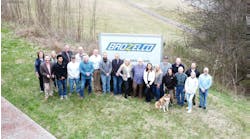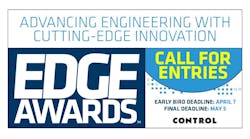Building on the momentum of its recent in-person and virtual events, the Mary Kay O’Connor Process Safety Center (MKOPSC) at Texas A&M University’s (TAMU) Engineering Experiment Station (TEES) attracted close to 400 attendees and 30 exhibitors at its Safety and Risk Conference 2024 on Oct. 21-24 in College Station, Tx. The event was co-located with the 79th annual Instrumentation and Automation Symposium and the first Ocean Energy Safety Day.
Plucked from among the event’s many presentations and exhibits, MKOPSC’s steering committee also bestowed several awards at the conference, including:
- Harry West service award to Mark Slezak, process safety and risk engineering manager at Oxy;
- Lamiya Zahin memorial safety award to Austin Johnes, graduate student at TAMU;
- Best paper award to Ganesh Mohan, process safety and risk manager at Chevron;
- Most innovative booth award to Oxford Flow;
- Best overall booth to ProLytx Engineering; and
- Best booth honorable mention to Softek Engineering
Getting more granular on safety
Steven Horsch, technical leader at Dow’s 58-year-old Reactive Chemicals Group, presented “Using calorimetry to understand reactive chemical hazards,” and reported most users are aware they need to know reactions and rates to avoid containment losses when manufacturing chemicals, but few know about more subtle measurement nuances that can alter those reactions and rates.
“To design a safe process, we need to know thermodynamics and energy-release rates, and measure vapor and complex pressures. Several types of calorimeters, such as adiabatic, can give us all the data we need,” said Horsch. “They can mimic processes, so we can perform accelerating rate calorimetry (ARC). It measures temperatures at boundaries, and can identify gradients indicating whether data is no good, and when to use ARC or not or not. This shows users they need to scrutinize what tests they’re using to check instruments, so they can generate the right data.”
For example, a simple equation can express measuring heat from an ARC, but more complex calculations are needed to demonstrate constant-volume heat capacity. “Likewise, if a user needs to know how much energy is coming from the heat of a reaction, the real-world process may be producing 315 joules per gram (j/g), while the ARC only shows 240-260 j/g, which means the resulting time requirements will be off,” explained Horsch. “This is why it’s crucial to examine what’s providing data, where it’s coming from, and whether it matches your actual scenario. Reaction kinetics from an ARC can be corrected using Fisher’s equation, but there may also be more complex reaction kinetics due to external heat pooling, which is a big-deal nuance. It’s not easy to collect the right data, but if you don’t have it, then you won’t get the right result. ARC can provide a lot of information to determine safe operating limits, but its limits must also be understood.”
Data-aided safety culture
In her presentation, “Learnings and improvements in process safety,” Bridget Todd, VP of enterprise health, safety and environment (HSE) at Baker Hughes, reported that users must execute non-negotiable safety tasks flawlessly, but they must also drive a culture of data-driven, continuous improvement in process safety, and use technology to make it happen.
“We begin by looking at data over the past several years, uncovering alarming issues or other items that were penciled in, and asking front-line staffers what could be done to make their lives safer and easier,” said Todd. “This make require a hard look in the mirror regarding training or other tasks. There’s often a disconnect between what works as imagined and work as it’s actually done, so managers have to step back, meet personnel where they are, and make certain that existing process safety steps are clear. It’s crucial to investigate and talk to employees about their jobs, and make sure they’re being candid and talking without fear of reprisals. These meetings can take several days, but this is how to reduce the disparity between how we imagine work is being done and how it’s actually being done. It’s also how to get holistic, and to get process safety governance on a checklist for 60,000 employees.”
Todd reported that Baker Hughes’ Enterprise Risk Avoidance program includes key performance indicators (KPI) that can be tracked quarterly, reported back to managers and boards, and contribute to high-level HSE audits. It also identifies risk areas and actions to take, requires all co-leaders to do monthly engagements and audits, and further demands that field leaders understand front-line issues. To reach managers and get them to follow up on these practices, the risk avoidance program also requires competence evaluations to make sure participants are doing their jobs capably and safely.
“Users typically find plenty of issues, so their subject matter experts (SME) conduct monthly reviews that identify all near-misses and other problems,” added Todd. “Because software is critical to process safety, too, we also started a Safe to Start policy and program that consults with everyone in the 120 countries where we work, and asks if they’re getting the tools and training they need to succeed at process safety. If issues are identified and competency is found to be light in some areas, then we can send an education team to help. It can perform tasks, such as establishing minimum safety barriers, informing front-line personnel why they’re doing checks, and setting up governance to confirm that users are doing the safety tasks they said they would.”
For instance, Todd explained that one Baker Hughes client is an artificial lift team that was experiencing some communications and management problems, and found it had gaps in how it was documenting its pump performance and pressure parameters. It subsequently engaged more closely with its front-line staff on risks and mitigations, and reminded all players why checking and documentation is important. Similarly, Baker Hughes serves some chemical plants that gathered safety performance data locally, but didn’t have a standardized way to track all of them, so they couldn’t show which ones were doing well compared to the others. Consequently, they implemented common documentation and reporting, and established a quarterly monitoring program. This enabled a standardized, global view that let the plants implement governance and holistic policies, which allowed them to see potential risks, and share lessons learned.
“Open, common metrics showed leading and lagging indicators, but it also demonstrated training compliance and engagement levels,” concluded Todd. “This enabled tighter governance of all their process safety tasks.”
Top-tier risk assessments
In her presentation, “Using operations and maintenance records for safeguards,” Angela Summers, founder and CEO of SIS-Tech Solutions, reported that the goal of risk assessments (RA) is to understand how causes lead to consequences, and reduce that risk as much as possible within reason and practicality, including investing in process safety until it hurts. One way to accomplish this is by using the American Petroleum Institute’s (API) Recommended Practice (RP) 754 standard, which organizes process safety indicators into four tiers, including:
- Tier 1—the most lagging indicator, which represents incidents with the greatest consequences, such as loss of containment.
- Tier 2—a leading indicator that may predict future, more significant incidents, such as loss of primary containment events with a lesser consequence.
- Tier 3—an indicator that provides an opportunity to identify and correct weaknesses within the safety system.
- Tier 4—an indicator that represents operating discipline and management system performance.
“Tiers 1 and 2 are matrices for very obvious and highly trackable events. They try to fix individual incidents in which something bad happened, but they’re limited by their focus on just one area,” said Summers. “Tiers 3 and 4 aren’t as well-defined, so they’re harder to track, but they can help users be proactive and fix lagging work practices. This is important because the prime obstacle for RAs is getting high-quality process safety data and reporting mechanisms, which meet the four criteria of credibility, justifiability, applicability and relevance.”
Summers added that Tier 4 is mainly concerned with diagnostics, but it also covers how often safety functions are performed or bypassed. Meanwhile, Tier 3 covers demands on safeguards, failures upon testing, monitoring and testing records, and how long processes have operated in unsafe states. “Process automation today is often so good that processes can go years without safety testing, and users often rely on these systems to tell them when it’s needed,” added Summers. “Users can also determine failure rates from testing records, but many try to justify longer periods between tests, which lawyers and insurers may interpret as sacrificing safety.”
Procedures to blame, too
In his presentation, “Cognitive ergonomics applied to IEC 61511 governed functions,” consultant Tom Shephard reported that traditional analyses of well-known disasters like Deepwater Horizon are likely deficient because they don’t employ enough situational awareness models, which add more policy and procedure context to incidents and their causes.
“If you’ve got a bad procedure, it’s just as bad as a bad transmitter,” said Shephard. “For example, exothermic catalytic bed reactors are covered by the IEC 61511 standard that’s performance-based, so users think its phases are performed as tasks,” explained Shephard. “However, a change comes when they consider engineering psychology, and learn that mistakes aren’t just due to operations personnel and their training, but can also be attributed to policies by their entire organization .”
Shephard added this kind of information has been available for decades, and includes bottlenecks in short-term memory (STM), such as recalling many details, limits and quirks until they eventually fade and get ignored. “Comprehension is another issue because data in someone’s head can be just like what’s in a transmitter, which means functions can be allocated among humans and digital systems as needed, and safety barriers can be applied the same way.”





